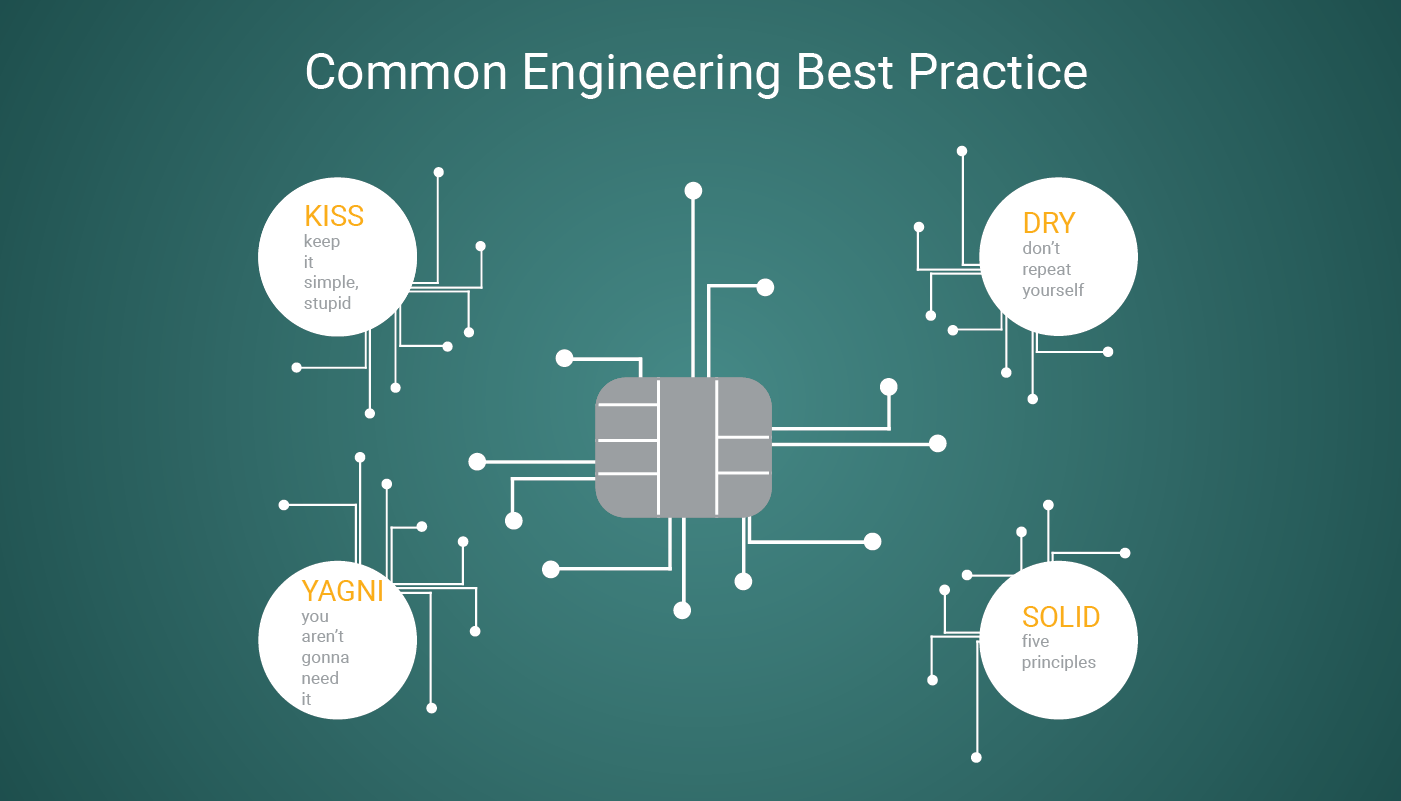What are the best software engineering practices, and why do you need them? To answer this question, you might recall your first music lessons when you were learning to play the guitar. You were told to place your fingers on the stings in the right position so that you could fret notes in the most convenient way possible. Incorrect finger placement is not always a disastrous thing, but you could always do better and faster once you learn the best guitar practices.
The same thing goes for programming. Good coding conventions and practices are common across the whole software engineering community, which helps to keep code in the best conditions for yourself, clients, and others who might work with it later. But before we consider several good software engineering practices, let’s define what that actually means.
Simply put, the best practice is a technique that is considered the most effective when reaching an objective.
We distinguish two types of best practices — common and programming language-related ones. Common (or general) practices are techniques that are common for all programming languages as well as markup ones, etc. It includes several community-accepted principles. The most popular ones are KISS, YAGNI, DRY, and SOLID. Programming language-related practices are those that might be specific to a particular language. Now, let’s see some examples of modern software engineering practices.
Contents
1. Common (General) Principles
2. Programming Language-related Practices
2.1. Code Smell Detection Tools
Common (General) Principles
1.1. The KISS Principle
This principle has nothing to do with the raucous band or the famous painting. The KISS abbreviation stands for “keep it simple, stupid” in the world of software development. It’s also known as “keep it simple and straightforward,” or “keep it simple, silly,” or whatever s’s you want to insert here.
The idea behind it is never-changing, though. You should keep your code as simple as possible. But what does “simple” mean here? It’s always a good idea to pick up meanings in a dictionary. For instance, according to The Free Dictionary, the word simple means having fewer parts or features, not complicated or elaborate. The definition perfectly suits engineering. Whenever you can avoid code, do avoid it.
A simple code is good for maintainability because you make it meaningful, simple, and straightforward. It means that you can always go back and see what’s going on. Thus, you can easily debug it and move on to your next task. Besides, with the help of this principle, you could help outsiders read your code and refactor it (in case you are not working on that code anymore). So, do learn the KISS principle and apply it in your work.
1.2. The YAGNI Principle
Nonetheless, it’s quite understandable when a diligent developer starts to meticulously plan everything that his project might need. But what you think might come in handy and be useful sooner or later, probably will never be used.
Being a highly professional software development company in the US, LITSLINK has a rational approach to software engineering. We follow the best development practices to ensure you get a high-quality code that is easy-to-read, scalable and can be used to improve your product after it hits the market.
1.3. The DRY Principle
DRY stands for“don’t repeat yourself,” and its underlying idea is that you have to avoid and reduce repetitions and redundancy by replacing those with abstractions or utilizing data normalization. For example, pseudocode is an excellent way to make sure you aren’t making any repetitions. You might be duplicating a bit of logic here or there, but you may want to merge them into a single function. For that reason, there’s only one mantra here — avoid repeating yourself in your code.
1.4. The SOLID Principle
Despite being a collective of software design principles, SOLID can also be used for functional programming languages as well. It stands for five practices, which are:
- Single responsibility principle
It states that everything should have its own place, and it should always be placed there. For instance, a class should be responsible for one thing only, and it has to own a specific name.
To understand this practice, you can imagine your disorganized dorm room where you’re frantically looking for something and what is more surprising initially you find the thing you need! To avoid the dorm-like mess in your coding, you can use the single responsibility principle.
- Open-closed principle (OCP)
If you need to extend functionality, you can add a new code instead of modifying the existing one. For instance, you might want to use JavaScript decorations, which is a perfect example of the open-closed principle.
- Liskov substitution principle (LSP)
You can check out the full definition of the Liskov substitution principle here. Named after Barabara Liskov, a computer scientist, this is an object-oriented programming principle that can make your code understandable and easy to read by helping you understand what best practice for inheritance is.
- Interface segregation principle (ISP)
Don’t make your code depend on methods that aren’t used by your clients. Simply put, ISP splits software into several smaller independent parts in order to minimize the effects caused by needed changes. To do so, you get your interface to fit a definite client.
- Dependency inversion principle (DIP)
The dependency inversion principle is the last one of SOLID. The main point of this practice is that you should never rely on something definite but on abstractions.The common illustration of DIP is when you want to plug in a home appliance so that you can use it, you plug it directly into a socket. You do not probe your wall to dig a hole in there to find wires to connect the appliance. You use the socket (the interface, the high-level module) and what’s behind (low-level modules) is not relevant for you.

Programming Language-related Practices
But everything is not so clear-cut and straightforward as with common or general practices when it comes to programming language-related principles and best practices. Each programming language has its own software engineering best practices and, what is more, they differ from front-end to back-end. Still, we can single out several such practices. Here are a number of language-related principles that you might find useful.
2.1. Code Smell Detection Tools
Code smells are not bugs or errors. But they signify certain patterns in code that might be defected and therefore lead to problems in terms of further development of software or/and its maintenance. For this reason, it’s vital to use code smell detection tools. Here are some examples of such tools — inFusion, JDeodorant, Stench Blossom (the names speak for themselves), and a few more.
2.2. Code Quality Tools
No one is safe from errors, especially when you’re developing software. You are likely to encounter a few on your way. In such a case, it’s always important to be on the safe side of things. That’s why you’d better use tools like linters (or lint tool) and cops. These tools will help you increase the quality of your code by automatically analyzing it and flashing out bugs, inconsistencies, and other errors.
2.3. Code Consistency
To maintain code, it needs to be consistent. Let’s look up the meaning at The Free Dictionary once again. According to it, consistent means in agreement, compatible, coherent, and uniform, and which is also not self-contradictory. Thus, code consistency means that your code at least suits the definition. Also, it helps you to wrap your head around your code and foresee how your software will behave hereinafter. So try to maintain your code as coherent as possible.
Wrapping Up
This is only a tiny fraction of software engineering practices that can be used in programming to create outstanding IT outsourcing case studies. You may not follow all of them, but it’s always good to stick to as many practices and their principles as you can. In this way, you’ll be able to alleviate the pain of those who might be working with your software later — your colleagues or uses. Besides, you can always find a lot more common and programming language-related practices. Just don’t forget to follow them in your work.





